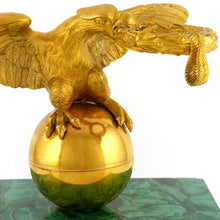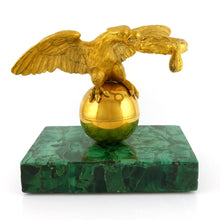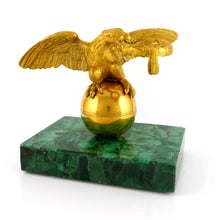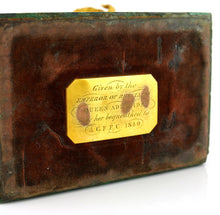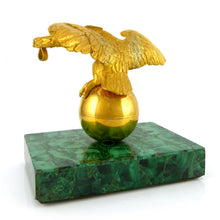A Royal Presentation Imperial Russian Watch Stand, 1844
Adding product to your cart
Overall: 12cm (4.7in) x 8.5cm (3.3in) x 12.5cm (4.9in)
Provenance:
Tsar Nicholas I of Russia (1796-1855)
Dowager Queen Adelaide of Great Britain (1792-1849)
Hon. Augusta Georgina Frederica FitzClarence (1824-1855)
George Frederick Boyle, 6th Earl of Glasgow (1825-1890)
Gilt bronze on malachite watch stand. The base inset with a period gilt plaque inscribed ‘Given by the / Emperor of Russia to / Queen Adelaide, / & by her bequeathed to A.G.F.F.C. 1849’.
Read more
A.G.F.F.C, or the Hon. Augusta Georgina Frederica FitzClarence (1824-1855) , was a granddaughter of Prince William Henry, Duke of Clarence (later King William IV, reigned 1830-37). She was the daughter of the rakish Lieutenant-General Lord Frederick FitzClarence (1799-1854), the third illegitimate son of Prince William by his mistress Dorothea Jordan. When the actress Mrs Jordan and Prince William split in 1810, there was little prospect that the latter would one day become king. The death of Princess Charlotte (only child of the Prince of Wales) in 1817 changed all that, sparking the famous royal baby race. Despite George III having many sons who between them sired numerous children there was not one living legitimate heir. Princess Adelaide of Saxe-Coburg and Meiningen was selected to marry Prince William. A double wedding ceremony ensued with William’s brother the Duke of Kent marrying Princess Victoria of Saxe-Coburg-Saalfeld. Despite a 27-year age gap, William and Adelaide were happy together. Adelaide fell pregnant several times, but miscarriages and stillbirths ensued, and two infants died young. It was the Duke and Duchess of Kent who succeeded in producing the next heir, Princess later Queen Victoria (reigned 1837-1901). Meanwhile Mrs Jordan died alone in poverty in France in 1816, and Queen Adelaide took it upon herself to show ‘an extreme kindness’ to her husband’s ten illegitimate children.
The present watch stand is thus a token of the affection that the Dowager Queen Adelaide extended to the illegitimate FitzClarences. Lady Munster, another of William IV's grandchildren, confirmed Queen Adelaide’s generosity when she wrote, ‘I feel more than rejoiced to be enabled now to give my affectionate and respectful testimony to the gracious and Christianlike love and tenderness ever offered to the poor actress's children by the Duchess of Clarence, afterwards Queen Adelaide, who, to the day of her death, treated the numerous FitzClarence family as only a loving and gentle woman could. I remember Queen Adelaide and her kind acts well, and know what it must have cost her tender heart at times to see this beautiful family around her (her husband's but not her own), and yet she ever loved them, and helped them with a mother's tenderness.’
An eagle, representing nobility, power and war, with a wreath of victor’s laurels clamped in its beak whilst perched upon a sphere, perhaps intended to symbolise global reach, might seem on odd gift for Queen Adelaide who generally eschewed pomp and ceremony. The watch stand says more about the Emperor Nicholas I of Russia. Both Nicholas and Adelaide grew up during the violence and turmoil of the Napoleonic Wars, but followed different paths in the latter stages of the Age of Revolution. Before the enactment of the Great Reform Bill of 1832 in Britain, Adelaide feared Queen Marie-Antoinette’s fate would be her own, when in actuality she afterwards enjoyed widespread popularity for her modesty and generosity in her adopted country. Nicholas I, on the other hand, is mainly remembered as a reactionary whose controversial reign was marked by geographical and economic expansion, centralisation and repression of dissent.
Nicholas visited Britain in 1844, staying at the Russian Embassy and at Windsor Castle. He made himself popular at Court by dispensing gifts and cash to courtiers and servants, but was unpopular with the ‘mass of the English people’ who saw him as a despot. On one occasion he was reportedly hissed at when driving out with the young Queen Victoria. Adelaide, who was the first Queen Dowager in over a century, was content to take a back seat but was always on hand to offer Victoria advice on queenship. Adelaide died at Bentley Priory, Middlesex and was interred at St. George's Chapel, Windsor. Augusta FitzClarence died at the home of her maternal grandfather the 4th Earl of Glasgow in 1855, presumably bequeathing the present watch stand along with the rest of her estate to her cousin George Frederick Boyle, the 6th Earl of Glasgow.






